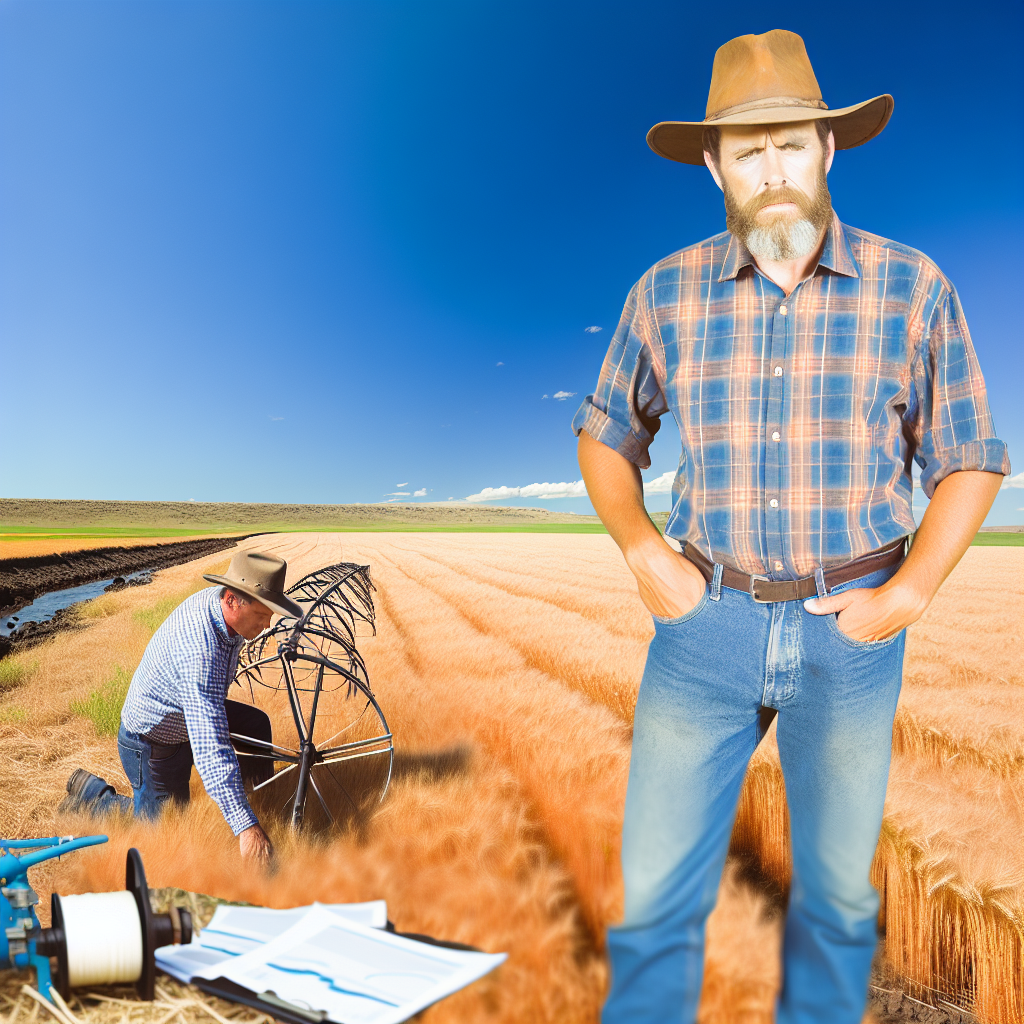Overview of Water Rights
Definition of Water Rights
Water rights refer to the legal entitlements securing the use of water resources.
These rights vary by region and are often regulated by government agencies.
Farmers heavily rely on these rights for irrigation and livestock needs.
Importance of Water Rights for Farmers
Water access is critical for agricultural productivity.
Farmers depend on consistent water supply for their crops and animals.
Without clear water rights, farmers can face significant operational challenges.
This uncertainty can lead to reduced yields and financial instability.
Moreover, understanding water rights helps farmers navigate legal challenges effectively.
Types of Water Rights
There are several types of water rights that farmers may encounter.
- Riparian rights allow landowners to use water from adjacent bodies.
- Prior appropriation rights grant water usage based on first claims.
- Groundwater rights apply to underground water sources.
Challenges in Water Rights
Farmers often face disputes over water rights with other users.
Moreover, climate change increases competition for limited resources.
Changes in regulation can complicate existing water rights.
These challenges impact farm operations and long-term planning.
Farmers must stay informed to protect their water rights effectively.
Historical Context: Evolution of Water Rights Legislation
The Importance of Water Rights
Water rights represent a critical aspect of agricultural sustainability.
Transform Your Agribusiness
Unlock your farm's potential with expert advice tailored to your needs. Get actionable steps that drive real results.
Get StartedFarmers rely on these rights to secure access to necessary water supplies.
Consequently, understanding their historical development is essential.
Early Water Rights Practices
In ancient times, societies established informal systems for water distribution.
Communities needed access to rivers, lakes, and streams for irrigation.
As populations grew, so did competition for these vital resources.
The Foundation of Legal Frameworks
The early legal frameworks emerged in response to increasing resource conflicts.
In the United States, states adopted the doctrine of prior appropriation.
This approach prioritized water rights based on the order of use.
Development of Water Rights Legislation
The first major water rights legislation appeared in the late 19th century.
This legislation aimed to regulate and clarify competing claims.
Over time, states developed their own laws to address local needs.
Modern Challenges and Adaptations
Today, water rights face significant challenges due to climate change.
The increasing frequency of droughts and floods complicates water management.
As a result, farmers often struggle to adapt to these shifts.
Continued Evolution of Water Rights
The evolution of water rights legislation reflects ongoing environmental and societal changes.
Understanding this history aids in addressing current and future challenges.
Types of Water Rights: Appropriative vs. Riparian Rights Explained
Understanding Water Rights
Water rights represent legal privileges concerning water usage.
Farmers must understand these rights to manage their resources effectively.
Primarily, two types of water rights exist: appropriative rights and riparian rights.
Appropriative Rights
Appropriative rights focus on water quantity rather than location.
They allow users to divert water from a source for specific purposes.
To secure these rights, users must demonstrate beneficial use.
Additionally, these rights operate on a first-come, first-served basis.
This means earlier rights holders have priority during shortages.
Showcase Your Farming Business
Publish your professional farming services profile on our blog for a one-time fee of $200 and reach a dedicated audience of farmers and agribusiness owners.
Publish Your ProfileBenefits of Appropriative Rights
Appropriative rights provide flexibility for farmers and businesses.
They allow for water use beyond riparian land boundaries.
This flexibility can enhance agricultural productivity significantly.
Challenges of Appropriative Rights
Acquiring and maintaining appropriative rights can be complex.
Farmers often face legal challenges regarding water allocation.
Additionally, these rights may require constant monitoring and management.
Riparian Rights
Riparian rights are tied directly to land adjacent to a water source.
Property owners automatically gain these rights as landowners.
These rights permit usage as long as it does not harm other users.
Benefits of Riparian Rights
Riparian rights generally entail fewer legal complexities.
Farmers benefit from predictable access to water sources.
This stability supports long-term agricultural planning.
Challenges of Riparian Rights
In times of water scarcity, competition can arise among users.
Consequently, access may become restricted during droughts.
Farmers are responsible for ensuring their water use is reasonable.
Key Differences Between Appropriative and Riparian Rights
Appropriative rights prioritize use over location, while riparian rights do the opposite.
This distinction creates varying legal implications for water access.
Farmers must assess the suitability of each right based on their needs.
Understanding Water Rights for Sustainable Agriculture
Understanding both types of water rights is crucial for farmers.
This knowledge enables them to navigate the complexities of water access.
Ultimately, effective management of these rights will support sustainable agriculture.
Explore Further: Tips for Complying with Water Usage Regulations
Challenges Farmers Face
Competition for Water Resources
Farmers often face intense competition for limited water resources.
This competition can arise from both agricultural and non-agricultural users.
In many regions, cities and industries prioritize their water needs.
As a result, farmers may struggle to access the water necessary for their crops.
Climate change exacerbates this issue by altering precipitation patterns.
Moreover, prolonged droughts can lead to severe water shortages.
Farmers must adapt by implementing more efficient irrigation practices.
Technologies like drip irrigation can significantly reduce water usage.
Additionally, crop selection plays a vital role in water conservation.
Farmers may opt for drought-resistant crops to cope with scarcity.
Furthermore, policies must evolve to better allocate water resources.
Governments can help by creating fair water-sharing agreements.
Public awareness campaigns can also elevate the importance of sustainable practices.
Ultimately, addressing these challenges requires collaboration among all stakeholders.
Farmers, consumers, and policymakers must unite for effective water management strategies.
Gain More Insights: Impact of Tax Changes on Agricultural Practices
Impact of Climate Change on Water Availability and Rights
Water Scarcity and Its Effects
Climate change leads to severe water scarcity in many regions.
This scarcity directly impacts agricultural productivity.
Showcase Your Farming Business
Publish your professional farming services profile on our blog for a one-time fee of $200 and reach a dedicated audience of farmers and agribusiness owners.
Publish Your ProfileFarmers struggle to secure enough water for their crops.
Consequently, water rights become a critical issue.
In some areas, competition for water escalates among users.
Changing Weather Patterns
Climate change alters traditional weather patterns.
This results in unpredictable rainfall and drought cycles.
Farmers must adapt to these changes for survival.
Moreover, changes in precipitation complicate water management.
Effective strategies become essential to mitigate these impacts.
Legal Framework and Rights
Water rights laws vary significantly across regions.
These laws influence how farmers access water resources.
Inequitable distribution of water rights often occurs.
In many cases, larger agribusinesses dominate access.
Small farmers face challenges securing necessary water supplies.
Impact on Crop Yield
Insufficient water resources can lower crop yields greatly.
Farmers may turn to alternative methods of irrigation.
However, these methods are often more expensive.
Investment in water-efficient technologies is crucial.
Such adaptation helps maintain productivity amid challenges.
Community and Collaboration
Collaboration among farmers can enhance water management.
Community-based solutions often prove effective.
Sharing resources and information builds resilience.
Local initiatives can promote sustainable water use.
Engagement with policymakers is also essential for change.
Uncover the Details: Enhancing Farm Operations with Food Safety Compliance

Legal Disputes
Case Studies of Water Rights Conflicts Among Farmers
Farmers often face serious challenges regarding water rights.
These conflicts can lead to significant legal disputes.
Understanding these cases provides valuable insights.
Case Study: The Thompson and Green Dispute
The Thompson family has farmed in Wasatch County for generations.
They rely on a nearby river for irrigation.
However, the Green family recently diverted more water from this river.
This led to a noticeable decline in water availability for the Thompsons.
Conflict arose as both families claimed senior water rights.
The case ultimately went to mediation to resolve the issue.
Case Study: The Larson Water Rights Case
In Oregon, the Larson Farm faced a legal challenge.
They sought to expand their irrigation system.
This expansion required access to a disputed water source.
Nearby farmers contested their claim, citing existing agreements.
The legal battle highlighted the complexities of water allocations.
Ultimately, a court ruled in favor of the neighboring farmers.
Case Study: Drought Impact on Water Rights
In California, severe drought exacerbated water rights conflicts.
Showcase Your Farming Business
Publish your professional farming services profile on our blog for a one-time fee of $200 and reach a dedicated audience of farmers and agribusiness owners.
Publish Your ProfileFarmers who historically had stable water access saw reductions.
In one case, the Rivera family faced restrictions on their water usage.
This imposed limitation directly impacted their crop yield.
Many farmers sought legal recourse to address these changes.
Ultimately, policymakers were forced to reassess allocation strategies.
Common Themes in Water Rights Conflicts
Many disputes arise from unclear water rights agreements.
Additionally, climate change significantly impacts water availability.
As populations grow, competition for resources intensifies.
Mediation often serves as a viable alternative to litigation.
Farmers frequently turn to local authorities for resolutions.
Strategies for Resolving Conflicts
Establishing clear communications remains crucial for farmers.
Regular meetings can help address potential issues early.
Moreover, farmers can benefit from forming cooperative agreements.
Utilizing technology for water monitoring presents new opportunities.
Overall, proactive approaches can mitigate future disputes.
Find Out More: Trade Policy Compliance for Agribusinesses
State Regulations: Variations in Water Rights Across Different Regions
Overview of Water Rights
Water rights govern how farmers use and manage water resources.
Different regions have distinct laws and practices regarding these rights.
This variation can significantly impact agricultural operations.
Riparian vs. Appropriative Rights
Most states follow two types of water rights: riparian and appropriative.
Riparian rights allow landowners to use water adjacent to their property.
In contrast, appropriative rights focus on water usage based on priority and need.
Farmers must understand which system applies in their region.
Regional Variations
Western states often use appropriative rights due to limited water supply.
In these areas, farmers face strict regulations on water use.
Conversely, eastern states commonly uphold riparian rights.
Here, water access often depends on ownership of adjacent land.
Environmental Regulations Impacting Water Rights
Environmental regulations complicate water rights for farmers.
Restrictions exist to ensure sustainable water usage and conservation.
Farmers may need permits to extract or divert water from natural sources.
Thus, the process can become lengthy and bureaucratic.
Challenges and Consequences for Farmers
Farmers face several challenges related to water rights management.
For example, obtaining permits can delay crucial agricultural activities.
Additionally, disputes over water rights can lead to costly litigation.
Consequently, uncertainty about water availability affects farm planning.
Adapting to Changing Regulations
Staying informed about changing regulations is essential for farmers.
Participation in local agricultural associations can help.
Networking provides valuable information regarding water rights and usage.
Farmers may also benefit from legal advice to navigate complexities.
Strategies for Farmers: How to Navigate Water Rights Challenges Effectively
Understand Your Water Rights
Knowing your water rights is the first step for farmers.
Showcase Your Farming Business
Publish your professional farming services profile on our blog for a one-time fee of $200 and reach a dedicated audience of farmers and agribusiness owners.
Publish Your ProfileThis knowledge helps in making informed decisions.
Research local and state regulations on water use.
Consult legal experts when necessary.
Keeping updated on changes in legislation is crucial.
Establish Relationships with Water Authorities
Building solid relationships with local water authorities can be beneficial.
Regular communication ensures you stay informed about water issues.
Participate in meetings and forums where water policies are discussed.
Be proactive in expressing your concerns and opinions.
Implement Water Conservation Practices
Adopting water conservation techniques can alleviate pressure on water supplies.
Consider using drip irrigation to minimize water waste.
Enhance soil management to improve water retention.
Utilize rainwater harvesting systems wherever possible.
Collaborate with Other Farmers
Joining forces with neighboring farmers can strengthen your position.
Collaborate to share resources and information about water rights.
Organize community efforts for better water management practices.
Engaging in cooperative agreements can yield benefits for all involved.
Stay Informed about Groundwater Regulations
Groundwater regulations often change, affecting many farmers.
Stay informed to ensure compliance with these regulations.
Participate in workshops and seminars focused on groundwater management.
Consider engaging consultants who specialize in water rights issues.
Document Everything
Maintaining thorough records is crucial for any farmer facing water rights challenges.
Document all water usage and any communication with authorities.
This information can protect you in legal disputes.
Ensure all records are organized and easily accessible.
Additional Resources
USDA Science and Research Strategy, 2023-2026: Cultivating …
Securing the future of US agriculture: The case for investing in new …




